|
Getting your Trinity Audio player ready... |
Tabla de Contenido/ Table of Contents
- 1 Miami-Dade Animal Shelter: How to Redesign a Failed System? #ActionsNotWords. A system under scrutiny amid new laws, public pressure, and institutional scandals.
- 2 💥 DIRECTLY RESPONSIBLE FOR THE VETERINARY COLLAPSE IN MIAMI-DADE. (Based on institutional competencies and administrative hierarchies)
- 2.1 🧑⚖️ 1. COUNTY MAYOR – Daniella Levine Cava
- 2.2 🪑 2. COUNTY COMMISSIONERS (especially the Animal Welfare Committee)
- 2.3 🏢 3. DIRECTORS OF THE ANIMAL SERVICES DEPARTMENT (ASD)
- 2.4 🧾 4. COUNTY AUDIT AND OFFICE OF MANAGEMENT AND BUDGET (OMB)
- 2.5 5. Key Decision-Makers Responsible for the Error in Selecting Inadequate Infrastructure:
- 3 🔍 ANALYSIS OF EXTERNAL CAUSES OF PET ABANDONMENT (BEYOND THE SHELTER)
- 4 Why residents of Miami-Dade County (and South Florida in general) abandon their pets.
- 4.1 🏚️ 1. ECONOMIC CRISIS AND COST OF LIVING
- 4.2 🛑 2. HOUSING COMPLEX PROHIBITIONS
- 4.3 🧠 3. LACK OF EDUCATION ABOUT RESPONSIBLE OWNERSHIP
- 4.4 📉 4. DESPAIR AND LACK OF PSYCHOLOGICAL SUPPORT
- 4.5 🐶 5. UNCONTROLLED BREEDING – UNWANTED LITTERS
- 4.6 ⚖️ 6. MIGRATION, LEGAL STATUS CHANGES OR DEPORTATIONS
- 4.7 ⚠️ 7. INCONSISTENCY IN LOCAL GOVERNMENT RESPONSE
- 5 🔍 INTERNAL SHELTER CAUSE ANALYSIS
- 5.1 🔍 Key Findings – Salary & Staffing Analysis at Miami-Dade Animal Services (FY2025)
- 5.2 🐾 Volunteers: The Shelters’ Silent Heroes
- 5.3 ⚠️ Silenced for Speaking the Truth
- 5.4 ✊ Testimony of Resistance
- 5.5 🚨 Alert
- 5.6 📌 Conclusions
- 5.7 ✅ Recommendations
- 5.8 🔍 CRITICAL ANALYSIS
- 5.9 📍 KEY ANALYSIS: PUBLIC VETERINARY UNDERSTAFFING IN AN OVERPOPULATED COUNTY
- 6 🔗 INTEGRATION WITH LEAN SIX SIGMA MODEL
- 6.1 Ishikawa Diagram
- 6.1.1 Objective 1: Increase Adoptions
- 6.1.2 Objective 2: Sanitary Control
- 6.1.3 Objective 3: Traceability Improvement
- 6.1.4 Objective 4: Operational Improvement
- 6.1.5 Objective 5: Resource Optimization
- 6.1.6 Objective 6: Reduce Euthanasias
- 6.1.7 ✅ Strategic Objective 7: Proactive Relocation to County Land Suitable for Animal Welfare
- 6.1.7.1 Current problem diagnosis:
- 6.1.7.2 🟩 Relocation proposal focusing on health, nature, and scale
- 6.1.7.3 County lands analyzed:
- 6.1.7.4 🧭 Strategic recommendation:
- 6.1.7.5 🌿 Infrastructure proposal (ideal model):
- 6.1.7.6 💬 Solution 7:
- 6.1.7.7 ✅ Strategic Objective 8: Partnerships with Universities, Technical Institutes, and Private Sector
- 6.1.7.8 ✅ Proposal:
- 6.1.7.9 Establish collaboration agreements with:
- 6.1.7.10 💡 Collaboration objectives:
- 6.1.7.11 Create a County Innovation Program where students can develop theses/internships on real county challenges:
- 6.1.7.12 🤝 Expected results:
- 6.1.8 🔍 Critical Analysis: Real relationships or mere references?
- 6.1.9 📋 Listed organizations:
- 6.1.10 ❓ Key questions:
- 6.1.11 ⚠️ Alert:
- 6.1.12 Proposal:
- 6.1.13 💡 Shelter application example:
- 6.1.14 🧠 Expected benefits:
- 6.1 Ishikawa Diagram
- 7 Change Cannot Wait
Miami-Dade Animal Shelter: How to Redesign a Failed System? #ActionsNotWords. A system under scrutiny amid new laws, public pressure, and institutional scandals.
Call to Action:
Shelter system reform cannot be cosmetic. It requires legal alignment, operational transparency, data-driven efficiency, and emotional reconnection with the public. Ignoring Florida’s current context only deepens the divide between the county and its residents.
💥 DIRECTLY RESPONSIBLE FOR THE VETERINARY COLLAPSE IN MIAMI-DADE. (Based on institutional competencies and administrative hierarchies)
🧑⚖️ 1. COUNTY MAYOR – Daniella Levine Cava
- 👉 Primary political and executive responsibility.
- Directly oversees the Animal Services Department.
- Approves or vetoes operational and personnel budgets.
- Her administration has prioritized PR events but failed to allocate real human resources to the shelter.
- No public veterinary expansion plan or response to demands from professionals, volunteers, and residents.
🔴 Result? A system with no real veterinary capacity, costly events, and thousands of animals without care or sterilization.
🪑 2. COUNTY COMMISSIONERS (especially the Animal Welfare Committee)
👉 Responsible for legislation and budget approval.
Voted for insufficient budgets or diverted funds to secondary expenses (events, buildings, administrative salaries).
Have not monitored or demanded verifiable results from the shelter.
Many avoid visiting the shelter or responding to public complaints.
🔴 Critical example: Commissioners approved million-dollar expenses without ensuring increased sterilizations or veterinary staff.
Chairman: Anthony Rodriguez, Vice Chairman: Kionne L. McGhee
Commissioners Members:
Oliver G. Gilbert, III (District 1), Marleine Bastien (District 2), Keon Hardemon (District 3), Micky Steinberg (District 4), Eileen Higgins (District 5), Natalie Milian Orbis (District 6), Raquel A. Regalado (District 7), Danielle Cohen Higgins (District 8), Kionne L. McGhee (District 9), Anthony Rodriguez (District 10), Roberto J. Gonzalez (District 11), Juan Carlos “JC” Bermudez (District 12), René Garcia (District 13)
🏢 3. DIRECTORS OF THE ANIMAL SERVICES DEPARTMENT (ASD)
👉 Operational and administrative responsibility.
Concealed or downplayed the veterinary staffing crisis.
Failed to establish strategic partnerships with universities, NGOs, or private clinics.
Did not prioritize efficient shift systems or mass sterilization campaigns despite evident overpopulation.
🔴 Example: Since 2022, the department knew fewer than 10 veterinarians couldn’t meet demand but continued operating as if sustainable.
🧾 4. COUNTY AUDIT AND OFFICE OF MANAGEMENT AND BUDGET (OMB)
👉 Tasked with controlling and optimizing public funds.
Did not implement mechanisms to track real impact per dollar spent.
Allowed funds to be directed to events, marketing, and external consultants instead of basic clinical services.
📌 CRISIS
This disaster results from shared negligence between the mayor, county commission, shelter directors, and budget offices. Instead of building a robust veterinary system, they turned the shelter into a PR showcase while its foundation crumbled.
5. Key Decision-Makers Responsible for the Error in Selecting Inadequate Infrastructure:
🔻 Critical Point: Inadequate Infrastructure – Adapted Shelters Without Animal-Centric Design
👉 Key decision-makers:
Carlos Giménez – As Miami-Dade Mayor in 2016, he was the primary executive responsible for the project’s planning and execution.
Jean Monestime – As County Commission Chairman at the time, he actively participated in approving and promoting the center.
Miami-Dade County Commissioners – The Board of Commissioners approved the funding and location of the center, endorsing the decision to establish it in an industrial zone.
Miami-Dade Animal Services Department – Headed by its director at the time, the department was responsible for the operational implementation and management of the center.
🧱 1. Flawed Origin and Design from the Ground Up
Both Miami-Dade County shelters—Doral (3599 NW 79 Ave) and Medley (7401 NW 74th Ave)—share a structural flaw in their origin: they were repurposed from industrial facilities never designed or built to house or treat live animals.
🔍 Doral Shelter:
- The center was officially inaugurated on June 13, 2016.
- Official classification: “Warehouse or Storage” – originally intended for logistics and storage.
- Location: Crudele Airport Industrial Park, a high-traffic zone with heavy cargo activity.
- Design: Metal walkways, low ceilings, no natural ventilation, no direct sunlight, no green areas or decompression zones for animals or humans.
- Core issue: The industrial design prioritizes cargo movement, not the clinical or emotional care of living beings.

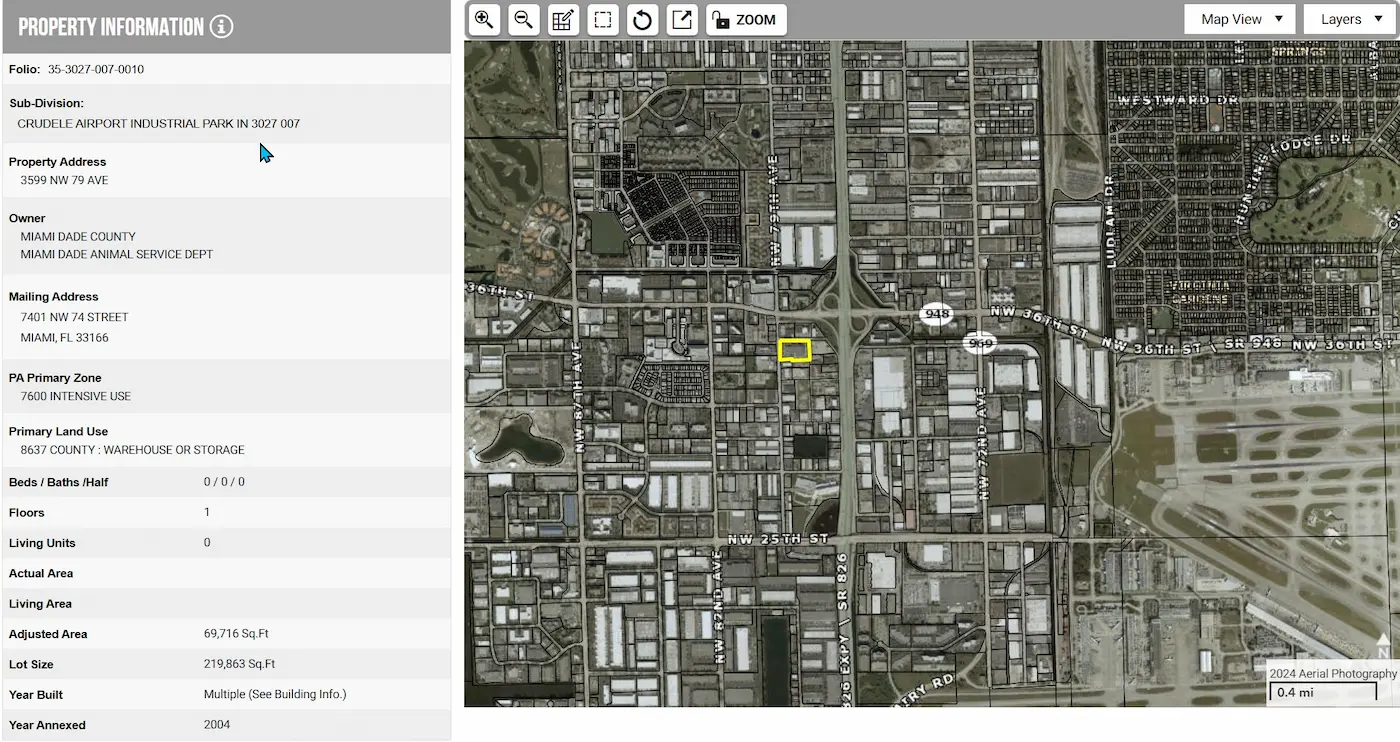
🔍 Medley Shelter:
- Structural origin: Former warehouse used as a fruit market, repurposed without infrastructure redesign or compliance with animal health regulations.
- Associated issues: Poor ventilation, lack of green areas or outdoor yards, overheating, noisy enclosed spaces, no acoustic or visual barriers.
- Direct impact: Chronic stress in animals, increased zoonotic diseases, aggression, and adoption difficulties.

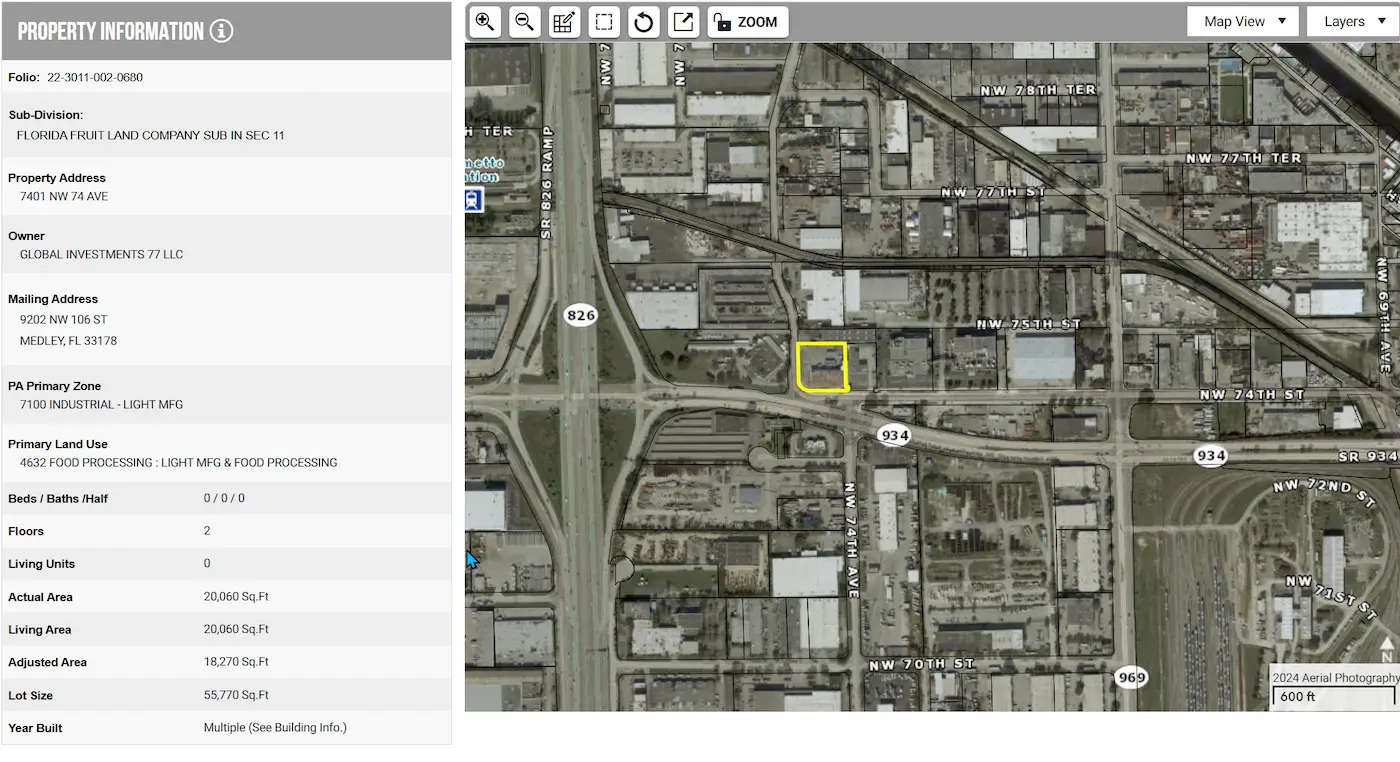
⚠️ 2. Consequences of Operating in Inadequate Structures
| Category | Direct Consequence |
|---|---|
| Animal health & sanitation | Higher disease exposure, lack of effective isolation, spread of infections. |
| Emotional well-being | Stressed, depressed, or aggressive animals. Environments lack enrichment or tranquility. |
| Adoption rates | Negative adopter experience: gloomy, noisy, unwelcoming facilities. |
| Staff & volunteers | Physical strain, disease exposure, emotional burnout, lower retention rates. |
| Institutional image | Negative public perception, eroded citizen trust, reduced donations. |
| Territorial inequality | Limited access for residents without vehicles. Industrial zones lack public transport. |
📌 3. Strategic Failures in Failing to Anticipate Population Growth & Modern Standards
Both shelters:
- Were conceived as animal storage spaces, not clinical, educational, or community centers.
- Lacked long-term vision, ignoring Miami-Dade’s demographic growth and evolving animal welfare standards.
- Failed to incorporate sanitary control technologies, digital traceability, or environmental sustainability.
🧭 Alert and Call to Action
The physical design of Miami-Dade’s animal shelters is not only inefficient but contradicts the very mission of the animal protection system. This structural flaw must be recognized as a strategic error that compromises the health, safety, and well-being of thousands of animals and citizens.
🔄 Structural Recommendation
- Progressive transition toward a comprehensive campus model, located in accessible areas with a community-focused approach and animal welfare-centered design.
- Complete redesign or relocation, starting by declaring the system as “essential infrastructure.”
- Master investment plan in biocentric design, with participation from NGOs, universities, and architects specialized in animal welfare.
🔍 ANALYSIS OF EXTERNAL CAUSES OF PET ABANDONMENT (BEYOND THE SHELTER)
🟠 LEVEL 1: COUNTY, SHELTER, AND CITIZEN ACTIONS
📍 Key Observations:
- The county manages two main shelters (Doral & Medley), both repurposed from structures not designed for animal housing (former postal office & fruit market).
- Reported issues: Medical negligence, unjustified euthanasia, veterinary staff shortages, technological deficiencies, budget opacity, and costly events with no real adoption impact.
- Volunteers, activists, businesses, and media have denounced: Lack of traceability, poor medical care, and institutional abuse.
- Public perception: Most animal lovers view the shelter as a failed institution, more focused on control than rescue.
🔎 Conclusion: There is a serious disconnect between the public’s demand for animal welfare and the county’s administrative management. This is not just an operational problem—it’s a crisis of credibility and institutional trust.
🟡 LEVEL 2: STATE LEGAL FRAMEWORK – FLORIDA’S NEW LAWS
📜 Key laws signed by Governor Ron DeSantis:
Pam Rock Act (HB 873)
- Requires owners of aggressive dogs to confine them in secure enclosures.
- Fines up to $1,000 per violation.
- In fatal attacks: Jail time + euthanasia (if prior warnings were issued).
- Strengthens animal control authority and adopter accountability.
Trooper’s Law
- Penalizes pet abandonment during natural disasters with:
- Up to 5 years in prison
- $10,000 fines
- Reinforces duty of protection during emergencies.
Dexter’s Law
- Publishes names of animal abusers in a statewide database.
- Promotes transparency and deterrence.
🔎 Conclusion: Florida’s legal framework has shifted toward zero tolerance for animal irresponsibility, forcing the county to:
- Update adoption procedures & post-adoption follow-up.
- Improve record-keeping & database management.
- Align with stricter enforcement standards.
🔵 LEVEL 3: DEMOGRAPHICS AND CULTURE OF MIAMI-DADE
📊 Key data:
Nearly 3 million inhabitants. Extremely high proportion of pet-owning households. Predominantly a strong animal-protection culture (animal lovers). Growing social pressure for animal welfare on social media, traditional media, and local events.
🔎 Conclusion: The county underestimates the reputational, legal and political impact of institutional neglect in the shelter system. 800 or 1,000 mismanaged animals in a county of millions is already a crisis, not due to absolute numbers, but because of citizen sensitivity.
Why residents of Miami-Dade County (and South Florida in general) abandon their pets.
Why residents of Miami-Dade County (and South Florida in general) abandon their pets, whether at shelters or on the streets, must be analyzed from a multi-causal perspective, considering social, economic, cultural and legal problems.
🏚️ 1. ECONOMIC CRISIS AND COST OF LIVING
Involved factors: Skyrocketing rents and housing prices. Widespread inflation (food, gasoline, veterinary services). Increased cost of medications and medical care for pets. Many people live in precarious or overcrowded conditions. Effect: When forced to choose between paying rent or buying food for their dog, they choose the former. The animal becomes an “unsustainable luxury.”
🛑 2. HOUSING COMPLEX PROHIBITIONS
Involved factors: Rental contracts that don’t allow pets. Sudden changes in HOA rules (condominium associations). Lack of low-cost pet-friendly housing. Effect: Many people move suddenly and have nowhere to take their pet, leaving them on the street or at shelters without alternatives.
🧠 3. LACK OF EDUCATION ABOUT RESPONSIBLE OWNERSHIP
Involved factors: No ongoing campaigns about owner responsibilities. Many believe animals “can take care of themselves” if left in a park. Unawareness of assistance programs (food, sterilization, medical care). Effect: Myths proliferate (“if I leave it at the shelter they’ll adopt it,” “it can survive on the street”) and abandonment becomes normalized as an “easy way out.”
📉 4. DESPAIR AND LACK OF PSYCHOLOGICAL SUPPORT
🧠 Key factors:
😞 Personal crises: Unemployment, depression, divorce or domestic violence. Domestic violence creates vulnerability that pushes pet care to the background.
👵🏼 Elderly sick adults: Can no longer care for their pets and receive no help.
🧩 Untreated mental health issues: Affect caregiving capacity and decision-making.
🏚 Traumatic evictions: Like the Sweetwater trailer evictions where homeless families abandoned pets due to lack of resources and time.
⚠️ Conclusion: Abandonment isn’t always cruelty. Often it’s desperation.
💡 SOLUTION: Emotional support programs, temporary shelters for pets in crisis, and immediate assistance hotlines for vulnerable families.
⚠️ Alert:
Abandonment isn’t always cruelty. Often it’s desperation.
💡 SOLUTION:
Emotional support programs, temporary shelters for pets in crisis, and immediate assistance hotlines for vulnerable families.
Direct effect: Lack of emotional support and social resources during critical moments leads many to leave their animals behind, not out of cruelty, but feeling overwhelmed and alone.
🐶 5. UNCONTROLLED BREEDING – UNWANTED LITTERS
Involved factors:
Unspayed/unneutered pets. Unplanned litters that owners can’t support. Lack of access to free sterilization programs or unawareness of them.
Effect: Owners abandon puppies or bring them to shelters when it’s too late, overloading the system and increasing euthanasias.
⚖️ 6. MIGRATION, LEGAL STATUS CHANGES OR DEPORTATIONS
Involved factors:
Sudden moves out of state/country. Deportations of migrants with pets. Job or city changes without ability to take pets.
Effect: Pets abandoned in empty homes, left with neighbors, surrendered to overwhelmed shelters, or simply left on streets.
⚠️ 7. INCONSISTENCY IN LOCAL GOVERNMENT RESPONSE
Involved factors:
Few sustained awareness campaigns. Scarcity of real assistance or incentives to prevent abandonment. Lack of effective response to complaints.
Effect: The tacit message received by the public is that “nothing happens if I leave it on the street.” Impunity leads to repetition.
Pet abandonment
Pet abandonment isn’t just irresponsible behavior – it’s a systemic consequence of broader problems:
Economic crisis. Emotional and social fragility. Ineffective public policies.
Disconnect between resident values and local government action.
Addressing just the shelters is insufficient.
We must treat the root causes:
education, legislation, social services, mental health, resource access, and visible institutional presence. Why do some abandon their pets?
💔 A human perspective on the problem
🔍 INTERNAL SHELTER CAUSE ANALYSIS
A comparison between administrative and general support staff at Miami-Dade’s Animal Services Department reveals a disparity that must be highlighted, especially considering physical effort, stress exposure, and operational workload.
🔍 Key Findings – Salary & Staffing Analysis at Miami-Dade Animal Services (FY2025)
🧑🤝🧑 Staff Overview
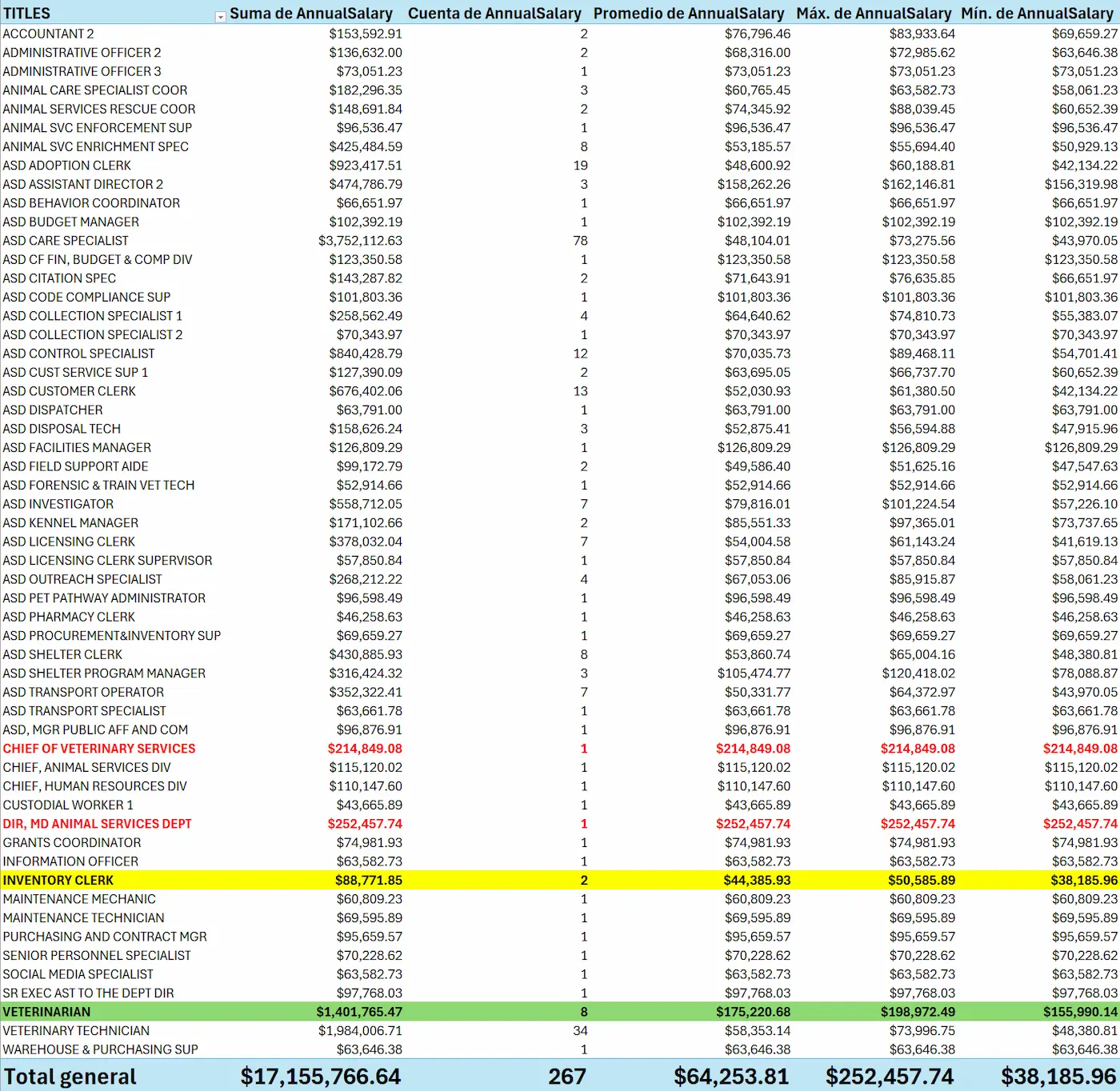
⚠️ Critical Disparities
➤ Highest Salaries:
- Animal Services Department Director: $252,457
- Chief of Veterinary Services: $214,849
- Veterinarians (8 total): $155,990 – $198,972
➤ Frontline Workers:
- Animal Care Specialists: $43,970 – $73,275 (Avg: $51,243)
- Adoption Staff: $42,134 – $60,188 (Avg: $49,876)
- Kennel Staff: $47,915 – $63,440 (Avg: $53,112)
🧾 Administrative Bloat
- 175 administrative employees, including 3 assistant directors earning $156,000–$162,000.
- Only 8 veterinarians for 2.5 million residents (1 vet per 312,500 people).
➤ Salary Comparison:
- Administrative Officers (5): $63,646 – $102,392
- Field workers (50+): 80% earn under $60,000.
⚙️ Structural Problems
➤ Non-veterinary roles with higher pay:
- ASD Assistant Directors: $156,000 – $162,000
- Budget/HR Managers: $102,000 – $126,000
➤ Critical roles with lower pay:
- Cleaning Staff: $43,665
- Animal Enrichment Specialists: $50,929 – $53,143
🚩 Notable Outliers
- Social Media Specialist: $63,582 (earns more than most animal care staff).
- Grants Coordinator: $74,981 (outearns veterinary technicians).
🐾 Volunteers: The Shelters’ Silent Heroes
Amid the institutional collapse of Miami-Dade’s shelter system, one group upholds the dignity of hundreds of animals daily: volunteers.
- They receive no salary.
- They don’t appear in county statistics.
- They have no air-conditioned offices or budgets.
Yet, they:
👉 Walk the “invisible” dogs.
👉 Bring food, blankets, and toys out of pocket.
👉 Lift up weak puppies… when the system had already given up on them.
⚠️ Silenced for Speaking the Truth
Instead of being recognized as strategic allies, many volunteers have been:
- Questioned, silenced, or expelled for documenting dirty cages, neglected animals, and unjust euthanasias.
- Demanding humane protocols, organized shifts, and accountability.
Yet, the administration treats them as enemies—when they are the conscience the system lost.
✊ Testimony of Resistance
“We don’t want applause. We want change. And as long as those dogs are there, I’ll keep walking in every day with a leash, a brush… and a heart ready to fight.”
— Anonymous volunteer, Doral Shelter
🚨 Alert
In the shelter equation, volunteers are not an add-on—they are a pillar deserving respect, voice, and protection. Excluding them for exposing failures perpetuates the cycle of institutional neglect.
📌 Conclusions
1️⃣ Veterinary shortage crisis: Only 8 vets for 300,000+ animals reflects structural abandonment.
2️⃣ Salary inequity: Frontline workers earn 30–50% less than administrators with minimal operational impact.
3️⃣ Misallocated funds: 175 admins vs. 7 enrichment specialists = excessive bureaucracy.
4️⃣ Unjustified executive pay: Director earns $252,000/year while shelter infrastructure collapses.
✅ Recommendations
- Reallocate resources: Prioritize veterinary hiring.
- Raise frontline wages: Especially for direct animal care roles.
- Cut redundant admin roles: Streamline for real efficiency.
*(Data based on FY2025 payroll. “MDC” = Miami-Dade County.)*
🔍 CRITICAL ANALYSIS
- Physical strain: Support staff face harsh, unsanitary conditions (foul odors, humidity, infection risks, overloaded shifts).
- Salary recognition: Despite this, their pay barely differs from desk jobs—institutional devaluation of operational effort.
- Admin excess: 175 admins vs. 7 support staff reveals a structural imbalance fueling systemic inefficiency.
- Turnover risk: Low pay + no incentives = high turnover, demoralization, and burnout in critical roles.
The current system prioritizes bureaucracy over operations.
In an animal shelter—where hygiene, maintenance, and direct care are vital to reduce disease, euthanasia, and boost adoptions—this imbalance is unjust and counterproductive.
📍 KEY ANALYSIS: PUBLIC VETERINARY UNDERSTAFFING IN AN OVERPOPULATED COUNTY
❗ CRITICAL DATA:
Miami-Dade, with 2.5M residents and hundreds of thousands of pets, has only 8 public veterinarians in its Animal Services Department—1 vet per 312,500 people.
🐶🐱 DIRECT IMPLICATIONS:
1️⃣ Spay/neuter system collapse:
- Sterilization is the foundation of population control.
- With 8 vets, meeting demand is mathematically impossible → uncontrolled breeding → abandonment → euthanasia → community conflicts.
2️⃣ Inability to handle emergencies:
- A skeleton team cannot simultaneously cover:
- Spay/neuter surgeries
- Clinical emergencies
- Post-op care
- Mobile programs (e.g., HOPE Express).
- Disasters, zoonotic outbreaks, or mass campaigns overwhelm the system.
3️⃣ Social inequality in access:
- Vulnerable populations rely on public veterinary services.
- Lack of low-cost/free sterilization forces families to choose between feeding their children or fixing their pets.
🔄 CHAIN REACTION:
Fewer sterilizations → More unwanted litters → More abandonment → More shelter intake → Higher public costs + more euthanasia → Eroded public trust.
This isn’t an operational problem—it’s a structural failure in public planning.
No animal welfare policy (no-kill goals, successful adoptions) can succeed without enough vets to sterilize animals in time.
With such an understaffed system, Miami-Dade’s efforts to protect animals are doomed from the start.
🔗 INTEGRATION WITH LEAN SIX SIGMA MODEL
| Lean Six Sigma Objective | Contextual Implication |
|---|---|
| 1. Increased Adoptions | Requires traceability, legally valid contracts, and compliance with laws like the Pam Rock Act. |
| 2. Sanitary Control | Mandatory quarantine rules, aggression control, legal classification of abandonment. |
| 3. Operational Improvement | Citizens demand efficiency + ethics. Operational failures now have legal consequences. |
| 4. Traceability Enhancement | Needed to comply with HB 593, Trooper’s Law, Dexter’s Law—verifiable tracking of dangerous/adopted animals. |
| 5. Resource Optimization | Events must show real social ROI (fewer euthanasias, more adoptions). Spending must be justified. |
| 6. Increased Public Trust | Shelters must shift from “institutional opacity” to “active transparency”—or face legal, media, and political fallout. |
| 7. Optimal Land Selection & Structural Design | Proactive Relocation to County Land Suitable for Animal Welfare |
| 8. Academic & Private Partnerships for Tech/Operational Solutions | Academic & Private Partnerships for Applied Tech, Operational & Social Solutions |
Ishikawa Diagram
Central Problem: Inefficiency in County Shelter Management
Objective 1: Increase Adoptions
Methods:
- F4 – Adoption processes misaligned with animal profiles
- F5 – No criteria for adopter evaluation
- F6 – Outdated sterilization schedules
- F7 – Poorly targeted campaigns
- F57 – Restricted hours limit adoptions
People:
- F11 – Volunteers lack formal training
- F16 – Staff overwhelmed by operational load
- F17 – Low volunteer retention
- F18 – No volunteer incentives/recognition
Materials:
- F8 – Outdated animal records
- F53 – Poor exterior signage/visibility
- F58 – Unwelcoming infrastructure lacking emotional design
- F159 – Industrial location discourages visitors
Environment:
- F1 – No interaction/enrichment zones
- F3 – Accessibility barriers for visitors
- F12 – No community neighborhood ties
Metrics:
- F9 – No campaign ROI tracking
- F10 – Budget not tied to adoption goals
- F13 – Slow/outdated legal processes
- F14 – Unclear legal frameworks
Technology:
- F60 – Adoption software not synced with inventory
- F121 – No post-adoption tracking
Objective 2: Sanitary Control
Methods:
- F22 – No health-adoption integration
- F25 – Incomplete euthanasia evaluations
- F45 – Improper medical waste disposal
- F59 – Frequent flooding from poor drainage
People:
- F37 – Untrained/non-rotating staff
- F41 – Insufficient sanitation shifts
- F158 – Vet staffing shortages
Materials:
- F20 – No isolation zones
- F31 – Underfunded basic supplies
- F33 – Poor digital medical management
Environment:
- F30 – No emergency preparedness
- F35 – Hazardous waste mismanagement
- F36 – Inadequate staff-to-animal ratios
- F49 – No AC in extreme heat
Metrics:
- F24 – Incomplete control records
- F32 – No sanitation cost analysis
- F134 – Unreported complication rates
Technology:
- F44 – No integrated health platform
- F151 – Data fragmented in Excel/manuals
Objective 3: Traceability Improvement
Methods:
- F21 – ID confusion
- F55 – Lost physical records
- F156 – Manual/non-digital registries
People:
- F72 – Contradictory staff instructions
- F66 – Duplicate data entries
- F75 – No microchip scanners
Materials:
- F65 – Outdated graphic materials
- F74 – Inefficient sample labeling
Environment:
- F76 – No automated alerts
- F50 – Dysfunctional storage
- F155 – No remote monitoring
Metrics:
- F56 – Incomplete medical/behavioral histories
- F62 – Unauthored reports
- F28 – Health records not integrated with events
Technology:
- F156 – No cross-department integration
- F67 – Data scattered across systems
Objective 4: Operational Improvement
Methods:
- F46 – Illogical clinical workflow
- F47 – Cramped spaces
- F160 – Improvised medical zones
- F94 – Redundant/unstandardized processes
People:
- F88 – No volunteer operational plan
- F92 – Staff task overload
- F129 – Operational burnout
Materials:
- F78 – Non-functional architecture
- F91 – Building structural limitations
- F18 – Volunteer supplies mismatched to tasks
Environment:
- F95 – No operational partnerships
- F77 – No logistical networks
Metrics:
- F80 – Unmeasured instruction impact
- F81 – Poorly documented workflows
- F96 – No unified digital system
Technology:
- F97 – Obsolete equipment
- F150 – Critical areas not integrated
Objective 5: Resource Optimization
Methods:
- F102 – No cost-effective sterilization strategy
- F104 – Improper legal classification
- F105 – Duplicative campaigns
- F130 – Wasted resources from poor planning
People:
- F120 – Overworked/unsupervised staff
- F125 – No digital volunteer protocols
- F119 – Unoptimized transport routes
Materials:
- F110 – Unmanaged supplies
- F113 – Duplicate/unused event materials
- F114 – Equipment not reused
Environment:
- F109 – Non-localized messaging
- F123 – Incompatible tools
- F157 – Obsolete/missing tech
Metrics:
- F106 – Unmeasured communication efficacy
- F115 – No cost-benefit comparisons
- F52 – No comprehensive digital platform
Technology:
- F122 – No digital inventory
- F124 – Operational data silos
Objective 6: Reduce Euthanasias
Methods:
- F2 – Non-clinical euthanasia criteria
- F48 – Euthanasia due to overcrowding
- F146 – Outdated euthanasia policies
- F153 – No overnight monitoring
People:
- F145 – Staff untrained for critical decisions
- F147 – No preventive health protocols
- F152 – No caregiver recognition
Materials:
- F138 – No recovery budget
- F54 – No post-op zones
- F135 – Insufficient community education
Environment:
- F144 – No night operations
- F139 – Failed tech integration
- F154 – No second-opinion reviews
Metrics:
- F134 – Unanalyzed post-surgery outcomes
- F132 – No emotional health metrics
- F133 – No euthanasia justification reports
Technology:
- F149 – No decision trail
- F151 – No external audit capability
✅ Strategic Objective 7: Proactive Relocation to County Land Suitable for Animal Welfare
Current problem diagnosis:
The county’s main shelter, located at 3599 NW 79 Ave (Doral), operates in a building originally classified as an industrial warehouse, without clinical design or features suitable for healthy animal living. The warehouse was adapted in an industrial environment without structural or environmental planning for housing animals. This has caused overcrowding, noise stress, sanitation failures, low adoption rates, and multiple public complaints. Its operation in an intensive storage area (original use: “Warehouse”) violates basic animal welfare principles.
The same occurs with the Medley shelter, which was an adapted commercial structure.
Given this reality, we propose as a strategic objective the identification, reservation, and adaptation of new county land that meets fundamental animal welfare criteria.
🟩 Relocation proposal focusing on health, nature, and scale
County lands analyzed:
| Folio | Location | Owner | Primary Use | Size | Advantages |
|---|---|---|---|---|---|
| 30-7827-000-0360 | Near SW 354th St & 192 Ave | Miami-Dade County (EEL Program) | Vacant Land – Governmental | 2,032,509 sq ft (≈46.6 acres) | Natural area adjacent to Navy Wells Pineland Preserve. Ample space, no industrial buildings, ideal for green areas and pavilions. |
| 30-7826-000-0080 | Continuation of above | Miami-Dade County (EEL Program) | Vacant Land – Governmental | 8,864,460 sq ft (≈203.5 acres) | Largest and most pristine tract. Potential to create an eco-friendly, self-sustaining animal campus with community integration. |
| 30-5936-000-0030 | Near Zoo Miami | Miami-Dade Parks & Recreation | Use: 8647 – Dade County | 11,325,600 sq ft (≈260 acres) | Has existing facilities and roads. Potential for cooperation with the zoo on shared educational and clinical plans. |
🧭 Strategic recommendation:
Of the three evaluated parcels, folios 30-7827-000-0360 and 30-7826-000-0080 represent the optimal option to build Miami-Dade’s new animal welfare campus because:
- Proximity to Navy Wells Pineland Preserve provides natural barriers and a calming environment for animals.
- Large areas without existing structures, ideal for building from scratch with animal-centered design.
- Potential to transform the space into a national model for ecological community shelters.
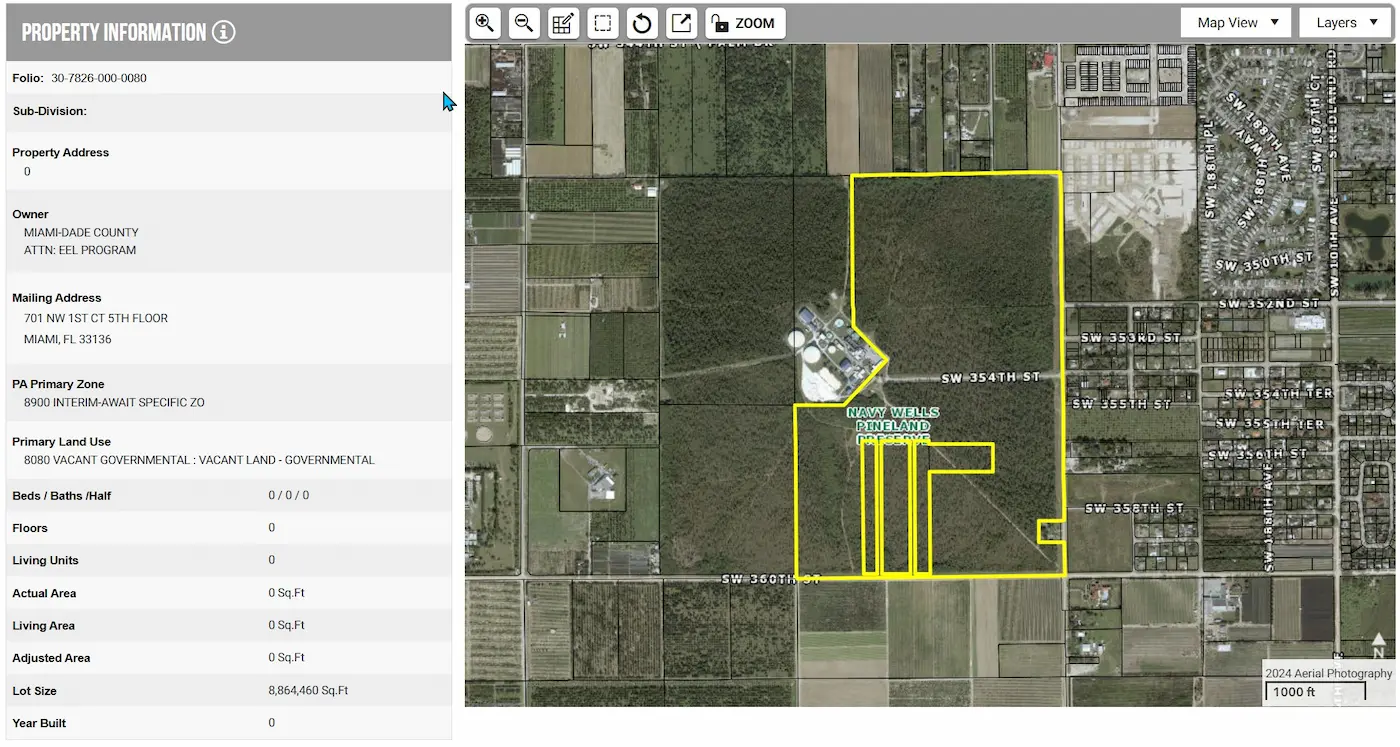
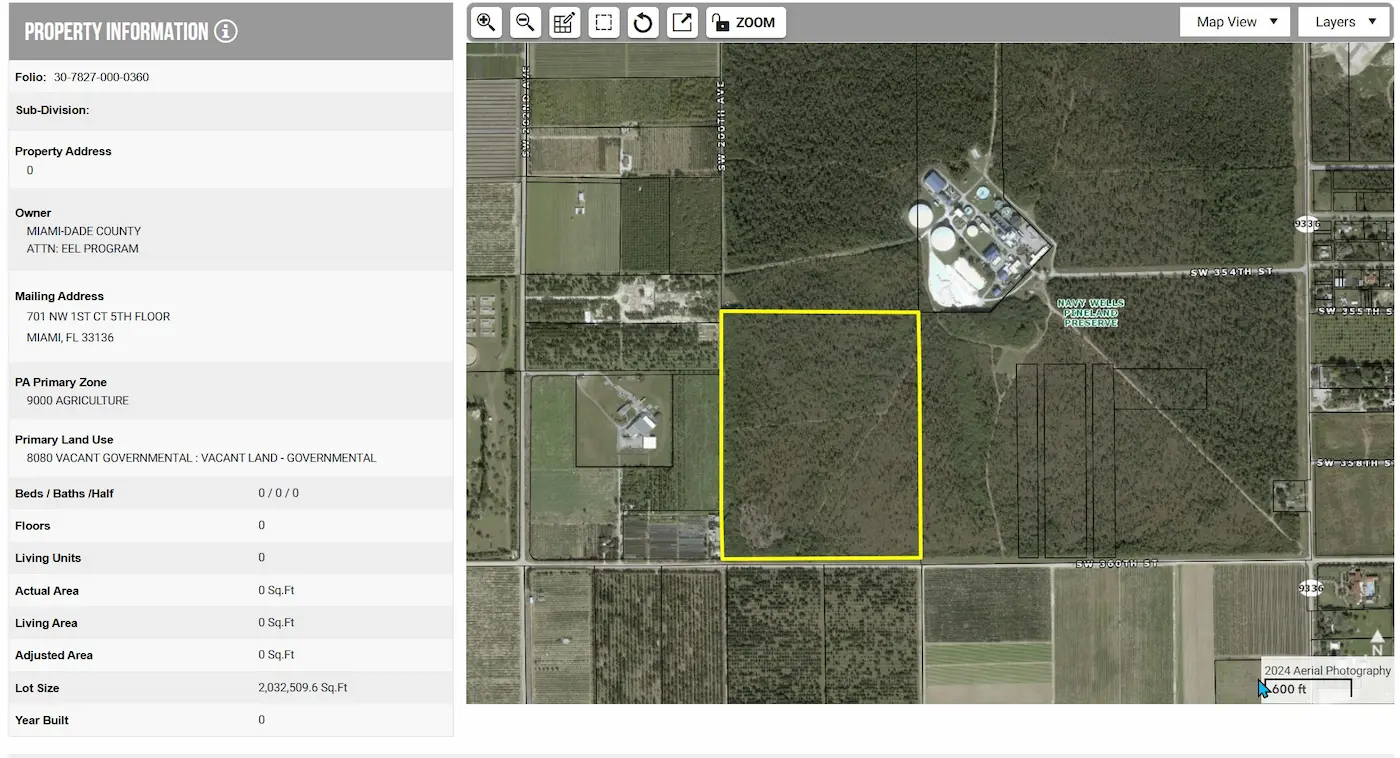
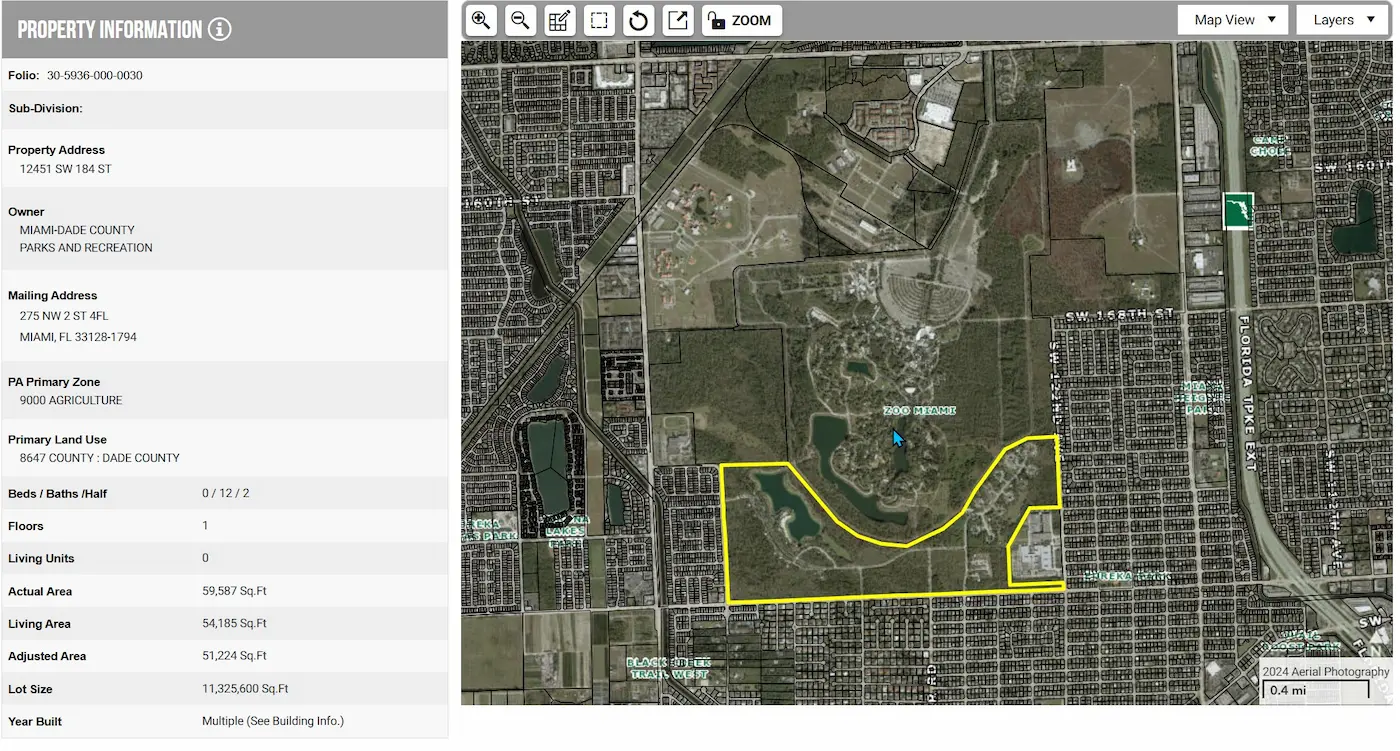
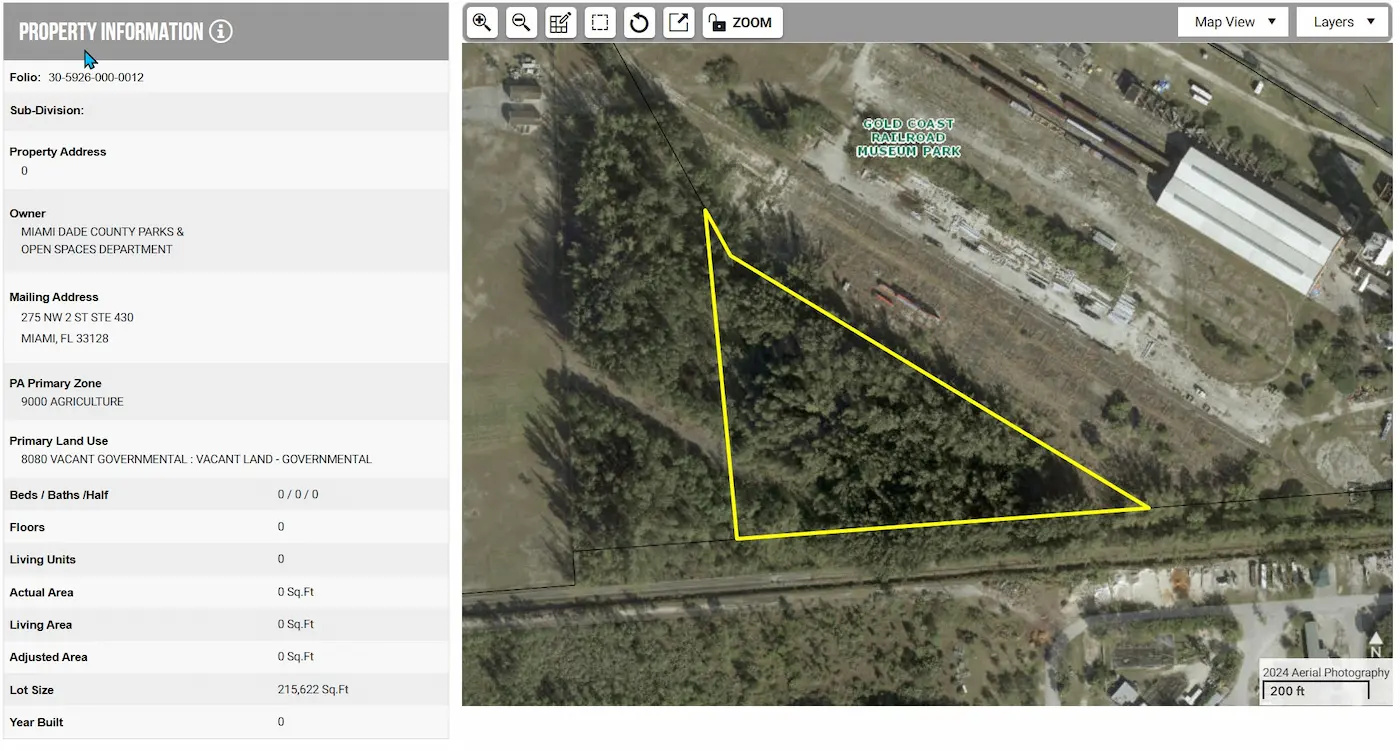
🌿 Infrastructure proposal (ideal model):
- Public veterinary hospital
- Species/condition-specific pavilions
- Emotional/behavioral rehabilitation zone
- Green recreation/socialization areas
- Educational park open to schools/visitors
- Modern adoption center with family focus
- Solar panels and community garden for self-sufficiency
- Housing for volunteers/internship programs
💬 Solution 7:
“An animal shelter shouldn’t be a warehouse extension, but a space that inspires empathy, health, trust, and community. The county has the land. It has the funds. It has the urgency. What’s missing is the political will to do what’s right.”
✅ Strategic Objective 8: Partnerships with Universities, Technical Institutes, and Private Sector
An efficient public system isn’t built in isolation. One of Miami-Dade’s greatest strengths is its academic, technological, and business ecosystem. However, to date, there’s no formal institutional strategy leveraging this potential to solve the shelter system’s multiple deficiencies.
✅ Proposal:
Establish collaboration agreements with:
Universities: Florida International University (FIU), University of Miami (UM).
Colleges/technical schools: Miami Dade College, D.A. Dorsey Technical College.
Private entities: Local tech startups, foundations like PetSmart Charities, Maddie’s Fund, and public solution software developers (Salesforce.org, Zudy, Qualtrics, among others).
💡 Collaboration objectives:
- University theses applied to:
- Animal tracking systems
- Digital platforms for adoption/volunteer management
- Automated post-adoption follow-up alerts
- Internships/degree projects with social impact
- Technology donations, open-source code, knowledge transfer
Create a County Innovation Program where students can develop theses/internships on real county challenges:
- Formal agreements with educational institutions
- Public recognition for implemented solutions with academic credits/civic mentions
🤝 Expected results:
- Reduce digital divide
- Optimize resources
- Strengthen government-citizen creative bonds
- Transform shelters into public innovation labs where young talent/digital tools solve real county problems
🔍 Critical Analysis: Real relationships or mere references?
The official Miami-Dade Animal Services website lists “related” non-county animal service agencies. However, it doesn’t clarify the type, scope, or concrete results of these relationships, raising serious questions about transparency/effectiveness of external collaborations.
📋 Listed organizations:
- Humane Society of Greater Miami
- Florida Fish and Wildlife Conservation
- Planned Pethood
- Broward Animal Services
- South Florida SPCA Horse Rescue
- Miami Animal Removal
- Wildlife Educational Programs
- Pelican Harbor Seabird Station
- Zoo Miami, among others.
❓ Key questions:
- Are there active formal agreements with these entities?
- No published MOUs, contracts, or collaboration reports
- What results have emerged from these alleged alliances?
- No public evidence of joint programs/sustained projects
- Are these active relationships or just phone listings?
- Most appear as mere informational references without structural involvement
- What role have these entities played regarding current abuse/overcrowding/euthanasia complaints?
- No public statements/joint inspections/coordinated actions
⚠️ Alert:
The county can’t claim strong animal protection connections just by listing agencies with phone numbers. Without formal agreements, joint protocols, or transparent results, these relationships are operationally/strategically empty.
Proposal:
Instead of nominal relationships, the county should establish verifiable strategic links to:
- Create effective adoption/education/rescue networks
- Strengthen crisis response capacity
- Share resources/trained personnel/technology
- Generate public reports showing alliance impacts
💡 Shelter application example:
A Software Engineering student team could design:
- Blockchain animal tracking
- Post-adoption mobile app with automatic notifications
- Real-time occupancy/health/public stats dashboard
- Interactive adoption campaign simulator
🧠 Expected benefits:
- Reduced tech development costs (replacing external consultants)
- Fostered local youth civic engagement
- Digitally updated key areas with locally-developed tech
- Open-source, replicable county solution bank
“Miami-Dade has the talent in its classrooms to solve these crises. We just need to build the bridge. This objective doesn’t just relieve the shelter system – it begins a new model: the thinking community solving its community’s problems. Modern governance doesn’t just hire consultants – it activates local minds.”
Change Cannot Wait
The Miami-Dade animal shelter isn’t failing by chance. It’s failing because it was poorly conceived, mismanaged, and abandoned by those who prioritized bureaucracy over welfare. The diagnosis is clear: a system installed in an incompatible industrial structure, with more bureaucrats than vets, where decisions prioritized public image over animal lives.
Yet this isn’t just criticism – it’s a reconstruction proposal. Today we have the data, evidence, social pressure, and technology to transform this failed model into a true animal protection/welfare system.
At News Miami Dade, we’ve rigorously documented:
✅ Structural/administrative failures
✅ Internal pay inequity
✅ Veterinary staffing crisis
✅ Preventable deaths
✅ System overload
✅ County’s silent abandonment
But we’ve also proposed solutions:
✔ Strategic relocation
✔ Legal reform/essential service declaration
✔ Tech integration/academic partnerships
✔ External audits
✔ Community activation
✔ Private sector/university links
This is a call to all: citizens, commissioners, leaders, media, professionals, and volunteers. The shelter isn’t just about animals – it’s a mirror of our humanity.
And if the State won’t protect those who can’t speak, then we must raise our voices.
🐾 “A dignified shelter isn’t a luxury. It’s a moral debt. Miami-Dade has the historic opportunity to pay it. It must not be wasted. We prefer saving pets and grandparents over watching our representatives spend our money on parties and events.”










